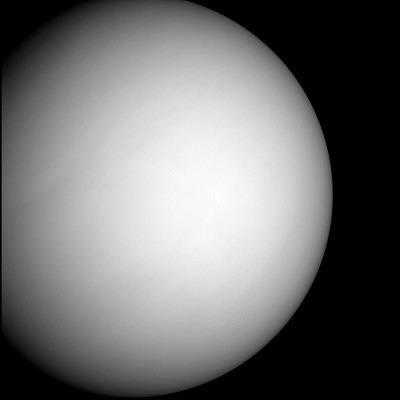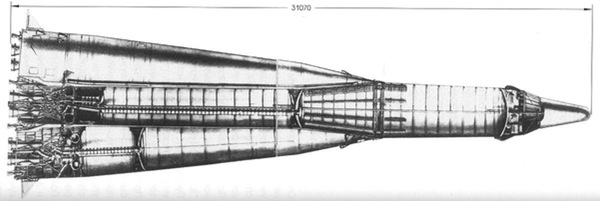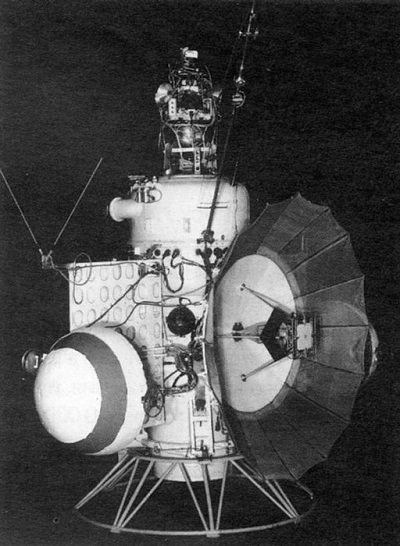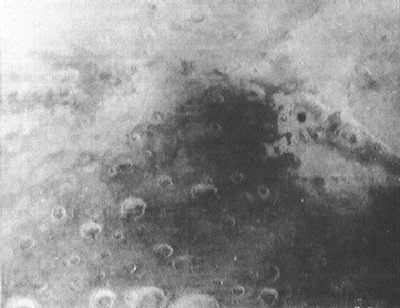
If at first you don’t succeed… (part 2)by Andrew J. LePage
|
| With the loss of all three Soviet and the first American Venus probes, only NASA’s Mariner 2 survived launch to make its way to Venus. |
With a brief reprieve, the Soviets continued their preparations. On August 25, 1962, 8K78 serial number T103-12 lifted off from Site 1/5 in what would become known as the Baikonur Cosmodrome, successfully placing its Blok L escape stage and the 2MV-1 No. 1 into a temporary 174-by-248-kilometer (108-by-154-mile) parking orbit with an inclination of 64.8 degrees. Just before ignition of the escape stage 60 minutes and 50 seconds after liftoff, four solid rocket motors were suppose to fire to settle the liquid propellants to the bottom of the Blok L tanks in preparation for engine ignition. Unfortunately, only three of the motors fired, sending the escape stage and its payload into an uncontrolled tumble. The escape stage’s S1.5400A1 engine only fired for 45 out of a planned 240 seconds, stranding the first 2MV-1 in Earth orbit. Unofficially designated “Sputnik 19” in the West, Soviet authorities never announced its launch as required by international agreements, and its orbit decayed just three days later.
Before Korolev and his team could make their second launch attempt, the Americans successfully launched Mariner 2 towards Venus on August 27, 1962. Because of the limited performance of the Atlas-Agena B compared to the Atlas-Centaur that was hoped to be available in time, Mariner 2 was basically a stripped down version of the Ranger Block I engineering test craft (see “Ranger: Voyage to the Moon and beyond”, The Space Review, August 22, 2011) with a total mass of 204 kilograms (448 pounds), of which just 9 kilograms (20 pounds) consisted of scientific instruments. Unlike the 2MV-2, Mariner 2 did not carry a camera. Intended to flyby Venus at a distance of about 29,000 kilometers (18,000 miles) on December 14, this was a much more modest spacecraft than the 2MV-series, but it was the first to get underway to Venus.
Five days later, on September 1, 1962, 8K78 serial number T103-13 lifted off from Site 1/5 at the Baikonur Cosmodrome successfully placing its Blok L escape stage and the 2MV-1 No. 2 into a temporary 185-by-246-kilometer (115-by-153-mile) parking orbit with an inclination of 64.8 degrees. But once again, failure would strike just as the escape stage was to fire 61 minutes and 30 seconds into the flight. A fuel valve failed to open and the main engine never received its fire command, stranding the Venus probe in a low Earth orbit that decayed five days later. Again Soviet authorities did not announce the launch and the wayward rocket was designated “Sputnik 20” by the West.
With the loss of the two landers and the end of the Venus launch window fast approaching, Soviet engineers and technicians hurriedly prepared the sole remaining spacecraft, the 2MV-2 No. 1 flyby craft, on 8K78 serial number T103-14. Launched on September 12, 1962, the rocket encountered a major problem 531 seconds after launch when a vernier chamber of the Blok I third stage’s 8D715K engine exploded just after attaining orbit because of a faulty LOX valve. Despite the mishap, the Blok L escape stage and its payload made it into a 163-by-195-kilometer (101-by-121-mile) parking orbit inclined 64.8 degrees to the Equator. Unfortunately, the escape stage’s engine fired for only a fraction of a second due to a failure in its LOX turbopump, stranding “Sputnik 21” in an orbit that decayed two days later.
With the loss of all three Soviet and the first American Venus probes, only NASA’s Mariner 2 survived launch to make its way to Venus. After a voyage of 109 days, Mariner 2 flew 34,827 kilometers (21,645 miles) above the surface of Venus and successfully carried out its experiments. And after an unbroken string of failed Ranger lunar missions over the course of 1962, it was a welcome success for NASA (see “The difficult road to the Moon”, The Space Review, January 23, 2012). Mariner 2 did not detect any breaks in the Venusian clouds and the surface temperature was estimated to be at least 425°C (800°F) with no measureable difference between the day and night surface temperatures. There was no detectable water vapor above the Venusian clouds and the best guess, based on all the Mariner and ground-based observations, was that the surface pressure was somewhere around 20 times that of the Earth.
Of course, today we now know that the surface conditions on Venus are even more extreme than scientists believed after the Mariner 2 mission, with a surface pressure of 92 times that of the Earth and a surface temperature of about 480°C (890°F). Had the Soviet 2MV-1 landers actually survived to reach Venus, they would have certainly returned vital in situ measurements of the Venusian atmosphere during their parachute descent but they would have been crushed at an altitude of 35 kilometers (22 miles) or more and never reach the surface intact. The 2MV-2 flyby craft could have returned additional information that would have supplemented the data from the less capable Mariner 2, but given the unbroken cloud layer that covers Venus, any images returned by the 2MV-2 would have shown a virtually featureless orb.
 If the Soviet 2MV-2 No. 1 spacecraft had survived launch and successfully returned images of Venus during its flyby in December 1962, they likely would have been similar to this nearly featureless visible light image of Venus acquired by NASA’s Mercury-bound Messenger mission almost 44 years later on June 5, 2007. (credit: NASA/APL/Carnegie Institute of Washington) |
As the Soviets were launching the 2MV probes to Venus, the sister craft to Mars were experiencing problems during their final push towards launch. For this launch window, a pair of 2MV-4 flyby craft and a single 2MV-3 lander were being prepared for missions that would be twice as long as their Venus-bound sister craft owing to their slower trajectories to a more distant target. The launch energy requirements to reach Mars in 1962 were much higher than they were for Venus and as a result the 2MV probes to Mars had to be correspondingly lighter with far tighter constraints on mass growth in order for the 8K78 to send them on their way. But as happens all too frequently in the development of new spacecraft, their estimated launch masses kept growing forcing changes to the mission plans and spacecraft.
| On October 27, Soviet military personnel at the cosmodrome were put on alert. All work on the preparation of the second and third Mars probes was suspended while workers were shifted to preparing combat-ready R-7A ICBMs for launch. |
The original launch window that extended from mid-October to mid-November of 1962 had to be shortened to just the last week of October and the first week of November when the launch energy requirements were near minimum, allowing the 8K78 launch vehicle to lift the maximum payload possible towards Mars. Engineers also made efforts to lighten the 2MV Mars spacecraft as much as possible. One of the victims of this effort was the life detection experiment that was to be carried by the sole 2MV-3 lander, which was removed after it failed to perform adequately in tests on the barren steppe outside of the Baikonur Cosmodrome.
As preparations for the launch of the Mars probes continued, Cold War tensions between the Soviet Union and United States were quickly escalating as the Cuban Missile Crisis unfolded on the other side of the globe because of the Soviet deployment of R-12 and R-14 IRBMs (known as SS-4 “Sandal” and SS-5 “Skean” in the West, respectively) on Cuban soil. On the morning of October 21, 1962, 8K78 serial number T103-15 carrying 2MV-4 No. 3 was rolled out to Site 1/5 for final checkout and preparation for launch. The next day President John F. Kennedy addressed the American people to inform them of the presence of Soviet IRBMs on Cuban soil. On October 23 President Kennedy signed an executive order setting up a naval blockade of Cuba to prevent any more Soviet missiles from reaching Cuba. As tensions between the superpowers continued to escalate to a dangerous new high, the first new Soviet Mars probe lifted off and was successfully placed into a 202-by-260-kilometer (126-by-162-mile) parking orbit with an inclination of 65.1 degrees.
 The R-7A ICBM (known in West as the SS-6 Sapwood) was the basis of the four-stage 8K78 that launched the 2MV probes to Venus and Mars. These missiles were readied for launch during the height of the Cuban Missile Crisis, delaying the launch of Mars 1 by three days. (credit: RSC Energia) |
After coasting for about 90 minutes, the Blok L escape stage ignited but its S1.500A1 engine exploded after only 16 seconds of operation because of a turbopump failure. The escape stage and doomed 2MV-4 No. 3 spacecraft broke up into two dozen pieces that were detected by the American early warning radar network. While it would have been quickly determined that this was not a Soviet missile attack, there were probably more than a few frayed nerves on the American side in the moments it took to determine that this was a non-military launch failure. As before, the Soviets never announced the launch and the now disintegrated spacecraft, designated “Sputnik 22” in the West, fell from orbit five days later.
On October 25, 1962, 8K78 serial number T103-16 carrying 2MV-4 No. 4 was rolled out to Site 1/5 for launching no later than October 29. This time around the events in Cuba would directly interfere with Korolev’s plans. On October 27, Soviet military personnel at the cosmodrome were put on alert. All work on the preparation of the second and third Mars probes was suspended while workers were shifted to preparing combat-ready R-7A ICBMs for launch. According to standing orders instituted under such circumstances, the launch of the 8K78 already on the pad was cancelled and it was to be removed to make room for a R-7A. After many frantic hours of phone calls between the cosmodrome and Moscow and a final resolution of the crisis by American and Soviet leaders on October 28 (which included the removal of Soviet missiles from Cuba in exchange for the removal of American Jupiter IRBMs in Italy and Turkey), launch preparations were free to resume.
After a three-day delay due to the crisis, the 8K78 carrying the second Soviet Mars probe lifted off on November 1, 1962, and was successfully placed into a 174-by-243-kilometer (108-by-151-mile) parking orbit with an inclination of 64.9 degrees. After completing a single orbit, the Blok L escape stage ignited and successfully placed the 893.5-kilogram (1,970-pound) 2MV-4 No. 4 on a 230-day trajectory towards Mars—by far the longest interplanetary mission ever attempted up to this point in the Space Age. This time Soviet authorities announced the launch, calling the new spacecraft Mars 1.
| Mars 1 was flying solo to the Red Planet with the hope that the Soviet Union would be the first to Mars. At very least, Mars 1 was already the first probe to be successfully launched towards Mars. |
On November 4, 1962, the last Mars probe, 2MV-3 No. 1, lifted off on 8K78 serial number T103-17. Unfortunately, a malfunction in the pressurization system of the Blok A core caused cavitation in the propellant lines, resulting in strong vibrations starting 260 seconds into the ascent. The Blok L escape stage and its Mars lander successfully made it into a 170-kilometer parking orbit inclined 64.8 degrees to the equator, but when time came to ignite the escape stage, nothing happened. Apparently the abnormally strong vibrations during powered ascent had shaken the escape stage’s ignition fuse out of its holder, stranding what the West designated “Sputnik 24” in its parking orbit. Various components of the escape stage and wayward Mars lander decayed from orbit between December 27, 1962, and January 19, 1963.
 The 2MV-4 No. 4 spacecraft that was called Mars 1 after its successful launch on November 1, 1962. (credit: RSC Energia) |
With no American Mars launches attempted during this window, Mars 1 was flying solo to the Red Planet with the hope that the Soviet Union would be the first to Mars. At very least, Mars 1 was already the first probe to be successfully launched towards Mars. But after the first communication session with the receding 2MV-4 spacecraft, it was beginning to look as though that might be the only achievement of Mars 1. Initial tracking from the Soviet ground control station at Yevpatoira in Crimea indicated that Mars 1 would pass within 500,000 kilometers (310,000 miles) of Mars and, as expected, a course correction would be required to place the spacecraft on a path that would reduce the flyby distance into the desired range of 1,000 to 10,000 kilometers (600 to 6,000 miles). However, telemetry also indicated that one of the two nitrogen gas tanks used for attitude control and to pressurize the course correction propulsion system was leaking and would be depleted in a matter of just a few days. Apparently contamination in a valve prevented it from shutting completely off, allowing the nitrogen gas to escape and sending Mars 1 into an uncontrolled tumble.
While ground controllers rushed to diagnose and correct the problem, astronomers at the Crimean Astrophysical Observatory swung into action. In order to determine the trajectory of the receding Mars 1, they used their 2.6-meter (102-inch) reflecting telescope to photograph Mars 1 and its Blok L escape stage against the stars starting at 4:50 AM Moscow time on November 2 at a range of 193,000 kilometers (120,000 miles). The Mars probe appeared as a fast-moving 14th magnitude star and over 350 photographs were taken following its position across the sky. This information combined with radio tracking helped to estimate that miss distance would be about 261,000 kilometers (162,000 miles).
Luckily, within a week ground controllers were able to regain control of Mars 1 using gas from the remaining nitrogen tank and, in order to conserve what little gas was left, they cancelled any course correction burns and set the probe into a slow flat spin to provide gyroscopic stabilization that would keep the solar panels facing towards the Sun allowing the batteries to be kept charged. While it would not be possible to use the directional high gain antenna for communications in this mode, the omnidirectional antenna could still be used and data from the particle and field experiments could be gathered to provide new and useful data on the interplanetary environment. Almost as important was the engineering data returned to help engineers evaluate the 2MV design and the experience of tracking and controlling an interplanetary spacecraft.
| One can only speculate on what Mars 1 and, had it survived launch and made it to its scheduled June 17 encounter date, 2MV-4 No. 3 might have discovered—the Tharsis volcanoes, Valles Marineris, chaotic terrain, and vast outflow valleys—and how that would have affected the next decade of Mars exploration. |
As Mars 1 continued on its journey gathering data with its instruments, communications sessions began to be held every five days instead of the two days during the earliest part of the mission. By March 1, 1963, Mars 1 was 79 million kilometers (49 million miles) from the Earth but the strength of its radio signals was declining, indicating a new problem. On March 21 telemetry from the 37th communication session indicated that the attitude control system had totally broken down, although all other systems seemed to be operating properly. Unfortunately, nothing was heard from Mars 1 again despite repeated attempts over the next few months. Based on the latest tracking information, Mars 1 flew silently past Mars on June 19 at an estimated distance of 193,000 kilometers (120,000 miles). Despite its problems, Mars 1 had operated for 142 days and was a record 106 million kilometers (66 million miles) from the Earth when it was last heard, surpassing the previous deep space communication distance record just set by the American Mariner 2 on January 3 when it was 86.7 million kilometers (53.8 million miles) from Earth 129 days after its launch.
Ironically, had Mars 1 been on a shorter duration Venus mission, it would have survived long enough to make a distant flyby with a month of life to spare. But if Mars 1 had survived and attitude control was not lost, its camera system alone would have been capable of returning up to two orders of magnitude more imaging data than NASA’s Mariner 4 mission, which reached Mars two years later. One can only speculate on what Mars 1 and, had it survived launch and made it to its scheduled June 17 encounter date, 2MV-4 No. 3 might have discovered—the Tharsis volcanoes, Valles Marineris, chaotic terrain, and vast outflow valleys—and how that would have affected the next decade of Mars exploration. Observations by the infrared spectro-reflexometer would have also failed to find any evidence of the Sinton bands long before it was discovered that these absorption features were the result of deuterated water (i.e. water with one of its pair of normal hydrogen atoms replaced with its heavier isotope, deuterium) in Earth’s atmosphere and were not evidence of life on Mars. These successes, coming on the heels of the successful dual flight of Vostok 5 and 6 (the latter of which carried the first female cosmonaut, Valentina Tereshkova), would have been an even larger propaganda win for the Soviet Union… if it had worked.
 Had Mars 1 or its sister craft, 2MV-4 No. 3, successfully completed their missions, they could have returned dozens of images with quality comparable to this photometric version of a Mariner 6 near encounter image of Terra Meridiani acquired six years later. (credit: JPL/NASA) |
Unfortunately, the 2MV-3 No. 1 Mars lander was doomed from the start. The Martian atmosphere in reality is just a few percent as dense as had been assumed by Soviet engineers (as well as American engineers at the time) and the spherical lander could not produce enough drag for a safe landing. The 2MV-3 lander was doomed to crash on the Martian surface without sending back any data on its scheduled June 21 encounter date. The scientific data from the cruise to Mars, the delivery of some commemorative pennants, and the claim of having been the first to impact Mars would have been the sole results. Unfortunately, the realization of just how thin the Martian atmosphere truly is was still some time off.
But even before Mars 1 had fallen silent, Chief Designer Sergei Korolev and his team at OKB-1 were already hard at work on the next generation of planetary probes, the improved 3MV series, to be launched in February/March 1964 towards Venus and that November towards Mars. Incorporating the hard lessons learned from a total of ten planetary mission attempts, it was hoped that the new series of planetary spacecraft and their 8K78 launch vehicle would have better luck.
Boris Chertok, Rockets and People Volume III: Hot Days of the Cold War (ed. Asif Siddiqi), SP-2009-4110, NASA History Division, 2009
Brian Harvey, Russian Planetary Exploration: History, Development, Legacy and Prospects, Springer-Praxis, 2007
Nicholas L. Johnson, Handbook of Soviet Lunar and Planetary Exploration, Univelt, 1979
Andrew J. LePage, “The Mystery of Zond 2”, Journal of the British Interplanetary Society, Vol. 46, No. 10, pp. 401–404, October 1993
Timothy Varfolomeyev, “The Soviet Venus Programme”, Spaceflight, Vol. 35, No. 2, pp. 42–43, February 1993
Timothy Varfolomeyev, “The Soviet Mars Programme”, Spaceflight, Vol. 35, No. 7, pp. 230–231, July 1993
Timothy Varfolomeyev, “Soviet Rocketry that Conquered Space Part 5: The First Planetary Probe Attempts, 1960–1964”, Spaceflight, Vol. 40, No. 3, pp. 85–88, March 1998
Andrew Wilson, Solar System Log, Jane’s Publishing Co., 1987
“Photographic Observations of the Mars Probe”, Sky & Telescope, Vol. 25, No. 1, p. 26, January 1963